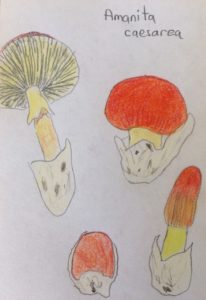…beautiful, some are edible, but don’t screw up the ID! As has been said, every mushroom is edible once.
I’ve been fascinated with Amanitas since not long after becoming a
fungiphile. Amanitas run the gamut from deadly poisonous to mind-altering to delicious. They remind me a bit of the Apiaceae plant family that includes two of the deadliest plants in North America — Poison Hemlock and Water Hemlock — while also boasting super helpful plants like Parsley and Angelica. In either case, your life depends on correct identification in the wild.
Edible Amanitas?? Yes. But, unless you are a very experienced mushroom hunter willing to be thorough in your identification, or are with someone who is and to whom you trust your life, don’t eat Amanitas. There are plenty of other delicious edibles out there. As has been often stated, your first mistake could be your last!
This time around, Amanitas in the Caesar’s Mushroom species complex are in the spotlight. Don’t worry, not all 90 of them (1). Just the most famous one, the true Caesar’s Mushroom, along with some North American members. Several North American species have been called “Caesar’s Mushroom” and are, indeed, relatives, but they are distinct species (2). Mushrooms in the Caesar’s complex get around; they’re on every continent but Antarctica (1)! Their taxonomy is far from complete. New species are being identified and previously identified species are being renamed. But that’s the trend now that genomics is replacing appearance for classification.
But the point is that before going out there and shoving anything that looks like a Caesar’s Mushroom in your mouth, realize that it’s not known whether all shrooms in the Caesar’s group are edible (2). And, there are poisonous lookalikes. For example, Amanita parcivolvata, found in the Appalachians and somewhat resembling a cross between Caesar’s Mushroom and Fly Agaric (3, 4). More on look- alikes later….
Though I include some information on mushroom appearance, because this is a strikingly beautiful group of mushrooms, the information I provide it is in no way sufficient to ID them in the field. The purpose here is to hopefully pique your interest into learning more. Introduce yourself to local mushroom foragers. Take some classes. Get some good ID books and wear them out! If you feel compelled to gather any of the Caesar’s group, find someone who has been collecting them and eating them for years (and is still alive!) and tag along with them.
Amanita caesarea – Ceasar’s Mushroom
I just paid a ridiculous amount of money for dried Caesar’s Mushroom and am trying to decide how I want to prepare it. It’s such a small amount that i don’t want to blow it. How to use it? A traditional Hungarian soup? A sauce? By itself and unadulterated except for with butter? Oh the torture…. As it’s name implies, Caesar’s Mushroom was a prized edible in ancient Rome. It’s still popular in Italy where one of it’s names is Ovulo Buono (Good Egg), reflecting its appearance as a young mushroom, its color and its flavor (5). The mushroom is most popular in the button stage (5) and is a choice edible also in Spain, Turkey, Hungary and elsewhere in Europe(6). In Rome it was said that “Gold and silver and dresses may be trusted to a messenger, but not a boletus, because it will be eaten on the way” (7), with “boletus” being Caeasar’s Mushroom rather than Porcini (Boletus edulis) (6, 7).
The Roman emperor Claudius was one famous eater of the mushroom. He came up in the Deadly Amanitas article in the last Plant Healer Magazine. His wife Agrippina and her accomplices tried to off him — to make way for her son Nero to ascend to the throne — by adding a poisonous mushroom extract to his favored Caesar’s Mushroom dish (7). Whether they succeeded the first time or had to try an additional poison is debated in the historical accounts….
In any event, Caesar’s Mushroom is gorgeous, with a bright orange to orange-red cap, yellow stalk and yellow gills. The cap often lacks remnants of the universal veil that encloses the embryonic fruiting body (8). (The white spots on top of Fly Agaric are veil remnants). The edge of the cap has vertical stripes referred to as “striations”. The stalk has a yellow, skirt like ring that is also a veil remnant. At the base of the stalk, usually partially (sometimes completely) buried in the ground, is a large, cup-like vulva that’s bright white on the outside (8). This is yet another remainder of the thick veil that the growing mushroom bursts out of. The inside of the stalk is “stuffed” with a cotton-like material. It, like Amanitas in general, grows in an ectomycorrhizal relationship with trees (8). This is a mutually beneficial relationship where the mushroom mycelia are linked to the tree roots. In the case of Caesar’s Amanita, this association is usually with Oaks.
The bright red and yellow pigments that Caesar’s Mushroom sports are alkaloids called betalains. Betalains are busy little molecules with a wide variety of activities, at least in the lab. For example, betalains from Caesar’s Mushroom protect lipids from oxidation (rancidity) and may have nerve-protective effects (9). Betalains are also anti-microbial (10) and consistent with this, Caesar’s Mushroom extracts inhibit clinically relevant bacteria including E. coli, Pseudomonas and Staph (11). Betalains also inhibit the growth of cancer cells (in a dish) and lower blood lipid levels (10).
Aside from betalains, Caesar’s Mushroom also contains beneficial polyphenols including p- coumaric acid, ferulic acid, catechins and cinnamic acid (11). p-coumaric acid has a whole slew of “anti-“ properties: Anti-inflammatory, anti-tumor, anti-microbial, and anti-anxiety, for example (12). It eases pain, reduces clotting and fever reduces inflammation, may improve metabolism (12). Ferulic acid is a strong anti- oxidant that may be useful for the nervous system, for heart health and for blood sugar regulation (13). Catechins are famous for being in Green Tea and influence cellular gene expression, metabolism, cardiovascular health and a whole slew of other things (14). Last but not least, cinnamic acid shows anti-oxidant, anti- microbial and anti-tumor activity (15).
Caesar’s Mushroom is decent source of protein, about 15% by dry weigh (16). Though it contains beneficial fats like oleic and linoleic acids (11), the levels in mushrooms are too low to be a significant dietary source.
Amanita jacksonii – American Slender Caesar
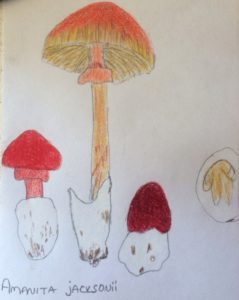 Amanita jacksonii is ridiculously beautiful as well as popular edible that hangs out with hardwoods in Eastern North America. The botanical name honors a Canadian artist and amateur mycologist who produced lovely mushroom paintings (17). This cousin of the European Caesar’s Mushroom is also known as Eastern Caesar’s Amanita, American Caesar’s Mushroom and a bajillion other combinations thereof. It’s range is thought to extend from Mexico to Canada (18) but recent data suggests that there may be at least 9 cryptic species in this range (1). These are mushrooms that look a lot like A. jacksonii but are actually separate species.
Amanita jacksonii is ridiculously beautiful as well as popular edible that hangs out with hardwoods in Eastern North America. The botanical name honors a Canadian artist and amateur mycologist who produced lovely mushroom paintings (17). This cousin of the European Caesar’s Mushroom is also known as Eastern Caesar’s Amanita, American Caesar’s Mushroom and a bajillion other combinations thereof. It’s range is thought to extend from Mexico to Canada (18) but recent data suggests that there may be at least 9 cryptic species in this range (1). These are mushrooms that look a lot like A. jacksonii but are actually separate species.
A. jacksonii and other shrooms in the Caesar’s complex are favored edibles in Oaxaca and are all referred to as “Beshia bella” (19, 20). They’re prized for their flavor, ease of preparation and size and for these reasons are one of the most culturally significant mushroom groups in Oaxaca based on ethnobotanical surveys (21).
A. jacksonii resembles true Caesar’s Mushroom in it’s flamboyant coloration, though it’s not as stout (hence the “American Slender Caesar” name). Like Caesar’s Amanita, A. jacksonii contains betalains (1), the same family of pigments found in beets and with all those great medicinal properties (22)! The cap ranges from a vibrant ruby red to bright orange to yellow- orange. Like Caesar’s Mushroom, the cap often lacks veil remnants on top. The gills are yellow to orangish, as is the stalk (23). The stalk is yellow but has an orange tint due to a layer of orange fibers. The ring around the stalk is skirt- like and ranges from yellowish to salmon to orange. The large vulva at the base is white on the outside (23).
Amanita arkansana – Arkansas Slender Caesar
A. arkansana was named as a species in 1926. It’s another edible 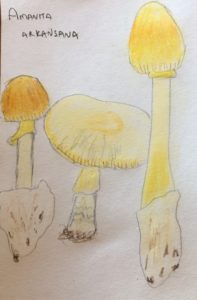 member of the Caesar’s complex, this one ranging around the southeast US in association with Pines and Oaks (19). A beautiful mushroom to be sure, though not as brightly hued as the shrooms discussed thus far. Some may even prefer the looks of A. arkansana. A bit less of the “look at me” and, perhaps, less reminiscent of the latest outfit worn by one’s crazy uncle.
member of the Caesar’s complex, this one ranging around the southeast US in association with Pines and Oaks (19). A beautiful mushroom to be sure, though not as brightly hued as the shrooms discussed thus far. Some may even prefer the looks of A. arkansana. A bit less of the “look at me” and, perhaps, less reminiscent of the latest outfit worn by one’s crazy uncle.
The cap is yellow to yellow-orange to orangish-brown, with striations around the edge. The color may fade to a creamy yellow with sun exposure and usually lacks veil remnants. (24). The gills start out light yellow to cream colored and fade to white over time. This is one of our taller Amanitas, with the stalk reaching over 17 cm tall (over 6 inches). The stalk is a pale creamy to white color with yellow bits along it. The the skirt-like ring is a pale yellow and the sack-like vulva, white (24).
Amanita cochiseana – Sun Caesar, Cochise’s American Caesar
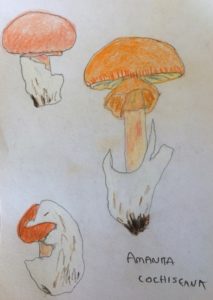 This provisionally named species found in the mountainous regions of Arizona, New Mexico, Northern Mexico and southwestern California growing under Pinon Pines and Oaks (25, 26). “Provisionally” means that the name isn’t official yet, for whatever reason. While it’s commonly called “Caesar’s Amanita” locally it, like the other mushrooms in this article, are separate species from true Caesar’s Mushroom. The name cochiseana refers to the region in which it was initially found (Coconino and Cochise counties in Arizona)(25).
This provisionally named species found in the mountainous regions of Arizona, New Mexico, Northern Mexico and southwestern California growing under Pinon Pines and Oaks (25, 26). “Provisionally” means that the name isn’t official yet, for whatever reason. While it’s commonly called “Caesar’s Amanita” locally it, like the other mushrooms in this article, are separate species from true Caesar’s Mushroom. The name cochiseana refers to the region in which it was initially found (Coconino and Cochise counties in Arizona)(25).
As with A. arkansana, there isn’t a whole lot of information available on A. cochiseana, other than that it’s edible, tasty and part of the Caesar’s section of Amanitas. Be aware that a lot of it’s range is on tribal lands. Please respect the applicable laws relevant to tromping around gathering mushrooms. For example, mushroom collecting by non-members of the White Mountain Apache is not allowed on their land (27).
Yet another pretty Amanita here. The cap is pale orange to buff colored possibly with bright yellow or yellow-orange around the margin, along with a bit of striation. Often bald, but sometimes with a single white and off center patch of veil (25). The gills are cream-yellow to orange-yellow, with the gill edges a brighter yellow. A great way to appreciate the color nuances is to get up close and personal with a magnifying glass. The stalk is white to cream to pale yellow towards the bottom and becomes brighter yellow to orange-yellow higher up. It has pale yellow-to-orangish scales. The ring is large and is yellow to orange (25). There may be a lower ring of similar color or ranging to grayish yellow but smaller. The volva is large and white (25).
For folks in the Flagstaff area there is a restaurant, Coppa Cafe, that features local wild mushrooms. I have seen (online) A. cochiseana listed on the menu once, though that was for the local mycological society’s dinner so I don’t know if it makes a regular appearance.
Coccora (Amanita calyptroderma & Amanita vernicoccora)
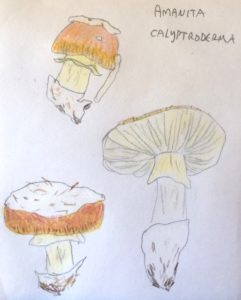 These edible Amanitas are found in Western North America and Central America and are closely related to Caesar’s Mushroom (28). They’re popular with Italian Americans in California who call them “Coccora”, in reference to the thick, cocoon-like universal veil surrounding the young fruiting body. Coccora are often served with pasta. Really, I can’t think of many edible mushrooms that wouldn’t go well with pasta….
These edible Amanitas are found in Western North America and Central America and are closely related to Caesar’s Mushroom (28). They’re popular with Italian Americans in California who call them “Coccora”, in reference to the thick, cocoon-like universal veil surrounding the young fruiting body. Coccora are often served with pasta. Really, I can’t think of many edible mushrooms that wouldn’t go well with pasta….
Of the mushrooms discussed here, Coccora are the easiest to confuse with deadly Amanita species. In fact, conditions in 1980 were ripe for profuse Death Cap (Amanita phalloides) fruiting in California. This resulted in multiple Death Cap poisonings among Italian Americans who inadvertently gathered Death Caps instead of their beloved Coccora (7). Though I’ve been foraging for edible mushrooms for 20 years and for medicinal mushroom for nearly 10, the only way I’d harvest Coccora would be with someone having many years of experience collecting and eating these mushrooms.
A. calyptroderma – Fall Coccora
The Fall Coccora is sometimes referred to as Ballen’s American Caesar. It’s common in California, where it fruits in the autumn beneath Live Oaks and Madrone (29). It’s range extends from British Colombia down into Guatemala, where it can be found for sale in road side stands (16). In the southern ranges it’s usually associated with hardwoods while up north, it’s more often found growing with conifers (30). The stalk, which is often hollow, is white to pale yellow with the characteristic Amanita ring and vulva (31).
A. vernicoccora – Spring Coccora
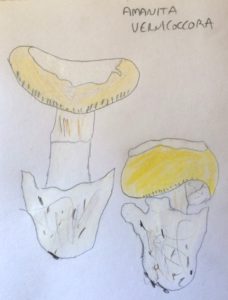 Spring Coccora fruits in California in (surprise!) spring. Until recently it was thought to be a lighter colored version of the autumn-fruiting A. calpytroderma. More careful analysis has shown them to be distinct species (28). The yellow-to- pale yellow cap of Spring Coccora is 6-18 cm across with striations at the margin. It’s topped with a blob of white veil remnant like icing on top of a cupcake (again with the food references!). Gills are white to pale cream (28). The white stalk is often hollow and is up to 14 cm tall, bearing a large white vulva at the base and a whitish-yellow ring.
Spring Coccora fruits in California in (surprise!) spring. Until recently it was thought to be a lighter colored version of the autumn-fruiting A. calpytroderma. More careful analysis has shown them to be distinct species (28). The yellow-to- pale yellow cap of Spring Coccora is 6-18 cm across with striations at the margin. It’s topped with a blob of white veil remnant like icing on top of a cupcake (again with the food references!). Gills are white to pale cream (28). The white stalk is often hollow and is up to 14 cm tall, bearing a large white vulva at the base and a whitish-yellow ring.
Spring Coccora grows in association with Live Oak, Blue Oak, Madrone and Manzanita along the California Coast in in the Sierra Nevada and Shasta Cascade foothills (28). Note that the lighter coloration of Spring Coccora compared to Fall Coccora makes it even easier to confuse with the deadly western Destroying Angel Mushroom, Amanita ocreata.
Other Coccora look-alikes that are toxic include Amanita gemmata and Amanita aprica, both native to the Sierra foothills (28). They fruit at the same time though there are some differences in appearance. For instance, A. gemmata has spots of veil bits on the cap, like Fly Agaric, rather than the central blob sported by Coccora. A. aprica does has a broad layer of veil membrane on the cap, but the layer is very thin, described as “frost-like”, unlike the thick layer on Coccoras. Though I wouldn’t trust myself to tell the difference. Especially since weather can wear the veil off the cap. A man confused A. gemmata for Coccora and ate several (he reported them to taste good) resulting in both a bad trip and some fun with gastrointestinal distress (32). A. gemmata contains muscimol and ibotenic acid, the same toxins found in Fly Agaric (33).
Coccoras are popular enough to make occasional appearances in the news, either regarding recipe uses and flavor ( “…somewhere between an egg and a fish…”)(34) or rightly warning about how easy it is to confuse them with Death Caps and Destroying Angels (35).
Coccora were and continue to be popular foods for indigenous populations of California. They’re called “Helli” by the Tuolumne Band of Miwok (spelled also as Miwuk, Mi-wuk and Me-wuk) (36). The Southern Miwok call them “Hahiya”, meaning “pine mushroom”(36). The Mono call them “ToopO”(36). These are all thought to be A. calyptroderma (Fall Coccora). Accordingly, some of the folks interviewed for this ethnobotanical survey of California mushrooms mention harvesting them in the fall. But, one of the interviewees said that she learned to look for ToopO when “the Black Oaks start leafing out” (36), so in the spring and suggestive of A. vernicoccora (Spring Coccora). No distinction is made by the authors of the report, and this isn’t surprising as the separation into A. calyptroderma and A. vernicoccora is recent. (Please forgive me for geeking out on this!)
Many interviewed in this report noted a noticeable lessening in mushroom number at traditional harvesting spots (36). This was attributed to land use issues (eg. increased housing developments), climate change as well as the cessation of traditional controlled burns. Such burns used to be carried out under host trees like Black Oak and Pine and resulted in increased mushroom numbers and size (36).
Anyway, the report is an interesting read if you’re into mushrooms….
Well that wraps up this segment of the Amanita series! I’m deciding on delving into more Amanitas next time versus taking a break and dorking out on a different fungiferific topic…
~~~
Content © Dr. Anna Marija Helt, Osadha Natural Health, LLC. Permission to republish any of the articles or videos in full or in part online or in print must be granted by the author in writing.
The articles and videos on this website for educational purposes only & have not been evaluated by the Food and Drug Administration. This information is not intended to diagnose, treat, cure, or prevent any disease or to substitute for advice from a licensed healthcare provider.
References
- Sánchez-Ramírez, Santiago (2015) Scaling macro- and microevolutionary dynamics in the Caesar’s mushrooms (Amanita sect. Caesaraea). PhD Thesis. Ecology and Evolutionary Biology. University of Toronto.
- Volks, T (2002) Fungus of the month – Caesar’s Mushroom. http://botit.botany.wisc.edu/toms_fungi/mar2002.html
- Kuo, M. Amanita parcivolvata. http://www.mushroomexpert.com/amanita_parcivolvata.html
- Roody, WC (2003) Mushrooms of West Virginia and the Central Appalachians. University Press of Kentucky.
- Amanita caesarea (Scop)-pers. – Caesar’s Mushroom. First Nature. http://www.first-nature.com/fungi/amanita-caesarea.php
- Gyozo Zsigmond (2010) The meanings and functions of mushrooms as food in Hungarian folk tradition. Acta Ethnographica Hungarica Published Online: June 09, 2010.
- fBenjamin, DR (1995) Mushrooms: Poisons and Panaceas. WH Freeman and CO, NY.
- Amanita caesarea. http://www.amanitaceae.org/?Amanita%20caesarea
- Li, Z et al (2017) Stress Activity Is Essential for Amanita caesarea Mediated Neuroprotection on Glutamate-Induced Apoptotic HT22 Cells and an Alzheimer’s Disease Mouse Model. Int J Mol Sci. 18(8) 1623.
- Gengatharan, A (2015). Betalains: Natural plant pigments with potential application in functional foods. LWT – Food Science and Technology. 64: 645-9.
- Dog?an, HH et al (2013) Biological activity and fatty acid composition of Caesar’s mushroom, Pharmaceutical Biology, 51:7, 863-871.
- Pei, K, et al (2016) p-Coumaric acid and its conjugates: dietary sources, pharmacokinetic properties and biological activities. J Sci Food Agric. 96(9):2952-62.
- Mancuso C & R Santangelo (2014) Ferulic acid: pharmacological and toxicological aspects. Food Chem Toxicol. 65:185-95.
- Khurana S, et al (2013) Polyphenols: benefits to the cardiovascular system in health and in aging. Nutrients. 5(10):3779-827.
- Sova M (2015) Antioxidant and antimicrobial activities of cinnamic acid derivatives. Mini Rev Med Chem. 12(8):749-67.
- Boa E (2004) Wild edible fungi: a global overview of their use and importance to people. FAO Technical Papers, 17 – Non-wood forest products. Food and Agriculture Organization of the United Nations, Rome.
- Tulloss, R (1986) What is the mushrooms North Americans have been calling “Amanita caesarea”? Boston mycological club bulletin. 41(3):10-13.
- McHugh, A. Amanita jacksonii, The eastern Caesar’s Amanita. Crazy about mushrooms. http://blog.crazyaboutmushrooms.com/amanita-jacksonii-eastern-caesars-amanita/
- Amanita caesarea: The Adventures of Caesar’s Mushroom. Mushroom appreciation https://www.mushroom-appreciation.com/amanita-caesarea.html#sthash.K0yFQD2k.dpbs
- Garibay-Orijel, R, et al (2006). People using macro-fungal diversity in Oaxaca, Mexico. Fungal Diversity 21: 41-67.
- Garibay-Orijel, R, et al (2007) Understanding cultural significance, the edible mushrooms case. J Ethnobiol Ethnomed. 2007; 3: 4.
- Kanner J, et al (2001) Betalains–a new class of dietary cationized antioxidants. J Agric Food Chem. 2001 Nov;49(11):5178-85.
- Amanita jacksonii. http://www.amanitaceae.org/?Amanita%20jacksonii
- Amanita arkansana. http://www.amanitaceae.org/?Amanita%20arkansana
- Amanita cochiseana. http://www.amanitaceae.org/?Amanita%20cochiseana
- Cripps, C, et al (2016) The essential guide to Rocky Mountain mushrooms by habitat. University of Illinois Press.
- May, C. Caesar’s amanitas are popping up on the White Mountain Apache Reservation. Arizona Mushroom Forum. http://arizona-mushrooms.org/2013/08/06/caesars-amanitas-on-the-white-mountain-apache-reservation/
- Bojantchev, D, et al (2011) Amanita vernicoccora sp. nov. —the vernal fruiting ‘coccora’ from California. Mycotaxon. 117:485-497.
- Veiss, D. Amanita calyptroderma/calyptrata/lanei. http://www.bayareamushrooms.org/mushroommonth/coccora.html
- Kuo, M. Amanita calyptroderma. http://www.mushroomexpert.com/amanita_calyptroderma.html
- Wood, M & F Stevens. California fungi – Amanita calyptroderma. http://www.mykoweb.com/CAF/species/Amanita_calyptroderma.html
- Bueg, MW (2010) NAMA Toxicology Committee Report for 2010 North American Mushroom Poisonings. North American Mycological Association.
- Karimi, G & BM Razavi (2014) Poisonous Mushrooms. Clinical Toxinology. 24 June 2014. 1-18
- Horgos, B (2013) Delight among the duff: Mushrooms offer texture, unique flavor to any dish. Santa Cruz Sentinel.
- McHugh, P (2006) If you consume, know your ‘shroom / The thrill of the hunt is risky, but has rewards. SF Gate.
- Anderson, K & FK Lake (2013) California Indian Ethnomycology and Associated Forest Management. J Ethnobiol. 33(1):33-85. 2013.

